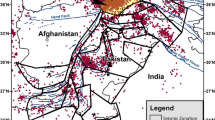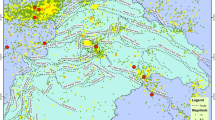Abstract
Earthquake prediction study is carried out for the region of northern Pakistan. The prediction methodology includes interdisciplinary interaction of seismology and computational intelligence. Eight seismic parameters are computed based upon the past earthquakes. Predictive ability of these eight seismic parameters is evaluated in terms of information gain, which leads to the selection of six parameters to be used in prediction. Multiple computationally intelligent models have been developed for earthquake prediction using selected seismic parameters. These models include feed-forward neural network, recurrent neural network, random forest, multi layer perceptron, radial basis neural network, and support vector machine. The performance of every prediction model is evaluated and McNemar’s statistical test is applied to observe the statistical significance of computational methodologies. Feed-forward neural network shows statistically significant predictions along with accuracy of 75% and positive predictive value of 78% in context of northern Pakistan.





Similar content being viewed by others
References
Adeli H, Panakkat A (2009) A probabilistic neural network for earthquake magnitude prediction. Neural Netw 22:1018–1024
Alarifi ASN, Alarifi NSN, Al-Humidan S (2012) Earthquakes magnitude predication using artificial neural network in northern Red Sea area. J King Saud Univ Sci 24:301–313
Ali Z, Qaisar M, Mahmood T, Shah MA, Iqbal T, Serva L, Michetti AM, Burton PW (2009) The Muzaffarabad, Pakistan, earthquake of 8 October 2005: surface faulting, environmental effects and macroseismic intensity. Geol Soc Lond Spec Publ 316(1):155–172
Anad M, Dash A, Kumar MSJ, Kesarkar A (2011) Prediction and classification of thunderstorms using artificial neural network. Int J Eng Sci Technol 3(5):4031–4035
Arshad J, Zameer A, Khan A (2014) Wind power prediction using genetic programming based ensemble of artificial neural networks (GPeANN). In: Proceedings of the 12th international conference on frontiers of information technology. FIT ’14, pp 257–262
Asencio-Cortés G, Martínez-Álvarez F, Morales-Esteban A, Reyes J, Troncoso A (2015a) Improving earthquake prediction with principal component analysis: application to Chile. In: Hybrid artificial intelligent systems: 10th international conference, HAIS 2015, Bilbao, Spain, June 22–24, 2015, Proceedings. Springer International Publishing, pp 393–404
Asencio-Cortés G, Martínez-Álvarez F, Troncoso A, Morales-Esteban A (2015b) Medium-large earthquake magnitude prediction in Tokyo with artificial neural networks. Neural Comput Appl 28:1043–1055
Asim KM, Idris A, Martínez-Álvarez F, Iqbal T (2016) Short term earthquake prediction in Hindukush region using tree based ensemble learning. In: 2016 International conference on frontiers of information technology (FIT), pp 365–370. doi:10.1109/FIT.2016.073
Asim K, Martínez-Álvarez F, Basit A, Iqbal T (2017) Earthquake magnitude prediction in Hindukush region using machine learning techniques. Nat Hazards 85(1):471–486
Awais M, Barkat A, Ali A, Rehman K, Ali Zafar W, Iqbal T (2017) Satellite thermal IR and atmospheric radon anomalies associated with Haripur earthquake (Oct 2010; M w 5.2), Pakistan. Adv Space Res. doi:10.1016/j.asr.2017.08.034
Barkat A, Ali A, Siddique N, Alam A, Wasim M, Iqbal T (2017) Radon as an earthquake precursor in and around northern Pakistan: a case study. Geochem J 51(4):337–346
Bath M (1965) Lateral inhomogeneities in the upper mantle. Tectonophysics 2:483–514
Broomhead DS, Lowe D (1988) Radial basis functions, multi-variable functional interpolation and adaptive networks. Technical report, DTIC Document
Cristianini N, Shawe-Taylor J (2000) An introduction to support vector machines and other kernel-based learning methods. Cambridge University Press, Cambridge
Fausett L (1994) Fundamentals of neural networks: architectures, algorithms, and applications. Prentice-Hall Inc, Upper Saddle River
Florido E, Martínez-Álvarez F, Morales-Esteban A, Reyes J, Aznarte JL (2015) Detecting precursory patterns to enhance earthquake prediction in Chile. Comput Geosci 76:112–120
Graves A, Mohamed AR, Hinton G (2013) Speech recognition with deep recurrent neural networks. In: 2013 IEEE international conference on acoustics, speech and signal processing, pp 6645–6649. doi:10.1109/ICASSP.2013.6638947
Gutenberg B, Richter CF (1954) Seismicity of the Earth. Princeton University, Princeton
Hall M, Frank E, Holmes G, Pfahringer B, Reutemann P, Witten IH (2009) The WEKA data mining software: an update. ACM SIGKDD Explor Newsl 11(1):10–18
Hassan A, Riaz F, Basit A (2015) A robust classification model with voting based feature selection for diagnosis of epilepsy. In: 2015 IEEE 28th Canadian conference on electrical and computer engineering (CCECE), pp 176–179. doi:10.1109/CCECE.2015.7129181
Haykin S (1998) Neural networks: a comprehensive foundation, 2nd edn. Prentice Hall PTR, Upper Saddle River, NJ, USA
Helmstetter A, Kagan YY, Jackson DD (2007) High-resolution time-independent grid-based forecast for M = 5 earthquakes in California. Seismol Res Lett 78(1):78–86
Ho TK (1998) The random subspace method for constructing decision forests. IEEE Trans Pattern Anal Mach Intell 20(8):832–844
Houlié N, Komorowski JC, de Michele M, Kasereka M, Ciraba H (2006) Early detection of eruptive dykes revealed by normalized difference vegetation index (NDVI) on Mt. Etna and Mt. Nyiragongo. Earth Planet Sci Lett 246(3–4):231–240
Idris A, Rizwan M, Khan A (2012) Churn prediction in telecom using Random Forest and PSO based data balancing in combination with various feature selection strategies. Comput Electr Eng 38:1808–1819
Ikram A, Qamar U (2015) Developing an expert system based on association rules and predicate logic for earthquake prediction. Knowl Based Syst 75:87–103
Jilani Z, Mehmood T, Alam A, Awais M, Iqbal T (2017) Monitoring and descriptive analysis of radon in relation to seismic activity of Northern Pakistan. J Environ Radioact 172:43–51
Jouanne F, Awan A, Pêcher A, Kausar A, Mugnier J, Khan I, Khan N, Van Melle J (2014) Present-day deformation of northern Pakistan from Salt Ranges to Karakorum Ranges. J Geophys Res Solid Earth 119(3):2487–2503
Kagan YY, Jackson DD, Rong Y (2007) A testable five-year forecast of moderate and large earthquakes in southern California based on smoothed seismicity. Seismol Res Lett 78(1):94–98
Kazmi AH, Jan MQ (1997) Geology and tectonics of Pakistan. Graphic Publishers, Karachi
Kazmi AH, Rana RA, Asrarullah, (1982) Tectonic map of Pakistan. Government of Pakistan, Ministry of Petroleum and Natural Resources
Keilis-Borok V, Kossobokov V (1990) Premonitory activation of earthquake flow: algorithm M8. Phys Earth Planet Inter 61:73–83
Keilis-Borok V, Soloviev AA (2003) Nonlinear dynamics of the lithosphere and earthquake prediction. Springer Science & Business Media, Dordrecht
Kemal A (1992) Geology and new trends for hydrocarbon exploration in Pakistan. In: Proceedings of international petroleum seminar, 22–24 November 1991, Islamabad, pp 16–57
Kossobokov V (1997) User manual for M8 algorithms for earthquake statistics and prediction. IASPEI Softw Libr 6:1–33
Kossobokov V, Romashkova L, Panza G, Peresan A (2002) Stabilizing intermediate-term medium-range earthquake predictions. J Seismol Earthq Eng 4:11–19
Last M, Rabinowitz N, Leonard G (2016) Predicting the maximum earthquake magnitude from seismic data in Israel and its neighboring countries. PLoS One 11(1):e0146101
Levenberg K (1944) A method for the solution of certain non-linear problems in least squares. Q Appl Math 2:164–168
Martínez-Álvarez F, Reyes J, Morales-Esteban A, Rubio-Escudero C (2013) Determining the best set of seismicity indicators to predict earthquakes. Two case studies: Chile and the Iberian Peninsula. Knowl Based Syst 50:198–210
Matthews BW (1975) Comparison of the predicted and observed secondary structure of T4 phage lysozyme. Biochim Biophys Acta Protein Struct 405:442–451
Morales-Esteban A, de Justo JL, Martínez-Álvarez F, Azañón JM (2012) Probabilistic method to select calculation accelerograms based on uniform seismic hazard acceleration response spectra. Soil Dyn Earthq Eng 43:174–185
Morales-Esteban A, Martínez-Álvarez F, Reyes J (2013) Earthquake prediction in seismogenic areas of the Iberian Peninsula based on computational intelligence. Tectonophysics 593:121–134
Murtza I, Abdullah D, Khan A, Arif M, Mirza SM (2017) Cortex-inspired multilayer hierarchy based object detection system using PHOG descriptors and ensemble classification. Vis Comput 33(1):99–112
Panakkat A, Adeli H (2007) Neural network models for earthquake magnitude prediction using multiple seismicity indicators. Int J Neural Syst 17(1):13–33
Pêcher A, Seeber L, Guillot S, Jouanne F, Kausar A, Latif M, Majid A, Mahéo G, Mugnier JL, Rolland Y, van der Beek P, Van Melle J (2008) Stress field evolution in the northwest Himalayan syntaxis, northern Pakistan. Tectonics 27(6):n/a–n/a. doi:10.1029/2007TC002252
Petersen MD, Cao T, Campbell KW, Frankel AD (2007) Time-independent and time-dependent seismic hazard assessment for the state of California: uniform California earthquake rupture forecast model 1.0. Seismol Res Lett 78(1):99–109
Pulinets S, Ouzounov D (2011) Lithosphere–Atmosphere–Ionosphere Coupling (LAIC) model-an unified concept for earthquake precursors validation. J Asian Earth Sci 41(4):371–382
Rafiei MH, Adeli H (2017) NEEWS: a novel earthquake early warning model using neural dynamic classification and neural dynamic optimization. Soil Dyn Earthq Eng 100:417–427
Ramar K, Mirnalinee TT (2012) An ontological representation for tsunami early warning system. In: IEEE-international conference on advances in engineering, science and management (ICAESM -2012), pp 93–98
Rehman K, Ali W, Ali A, Ali A, Barkat A (2017) Shallow and intermediate depth earthquakes in the Hindu Kush region across the Afghan-Pakistan border. J Asian Earth Sci. doi:10.1016/j.jseaes.2017.09.005
Reyes J, Morales-Esteban A, Martínez-Álvarez F (2013) Neural networks to predict earthquakes in Chile. Appl Soft Comput 13(2):1314–1328
Sercombe WJ, Pivnik DA, Wilson WP, Albertin ML, Beck RA, Stratton MA (1998) Wrench faulting in the northern Pakistan foreland. AAPG Bull 82(11):2003–2030
Utsu T, Ogata Y, Matsu’ura RS (1995) The centenary of the Omori formula for a decay law of aftershock activity. J Phys Earth 43:1–33
Wang Q, Guo Y, Yu L, Li P (2017) Earthquake prediction based on spatio-temporal data mining: an LSTM network approach. IEEE Trans Emerg Top Comput PP(99):1–1. doi:10.1109/TETC.2017.2699169
Williams RJ, Zipser D (1989) A learning algorithm for continually running fully recurrent neural networks. Neural Comput 1(2):270–280
Yan T, Pietrafesa LJ, Dickey DA, Gayes PT, Bao S (2015) Seasonal prediction of landfalling hurricanes along Eastern Seaboard of the United States. Int J Climatol 35(9):2647–2653
Acknowledgements
The authors would like to thank friends and colleagues for nice suggestions, in particular, Mr. Iqbal Murtza for his valuable remarks and guidance. Spanish Ministry of Science and Technology, Junta de Andaluca and University Pablo de Olavide under projects TIN2011-28956-C02, P12-TIC-1728 and APPB813097 are also acknowledged.
Author information
Authors and Affiliations
Corresponding author
Rights and permissions
About this article
Cite this article
Asim, K.M., Awais, M., Martínez–Álvarez, F. et al. Seismic activity prediction using computational intelligence techniques in northern Pakistan. Acta Geophys. 65, 919–930 (2017). https://doi.org/10.1007/s11600-017-0082-1
Received:
Accepted:
Published:
Issue Date:
DOI: https://doi.org/10.1007/s11600-017-0082-1




